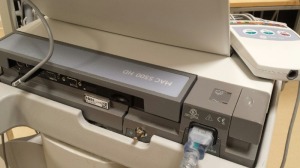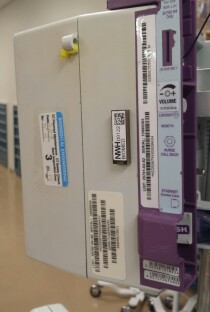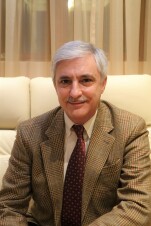How passive RFID for asset tracking can improve care delivery
May 16, 2018
By David Stotland
Northern Westchester Hospital (NWH), a 245-bed acute-care facility in Mount Kisco, New York and a member hospital of Northwell Health, has always had an interest in innovation. So, when it was time to seek out and implement a technological system that would provide automated data about equipment location, compliance with periodic automatic replenishment (PAR) levels, and analytics to observe trends, we were well equipped to begin the journey.
NWH is a process-driven organization. Before even piloting the RFID system, we already had a set of operational business processes in place and our idea was to select the best technology that fits the existing business processes in order to take advantage and have them develop.
Starting in 2013, the hospital’s biomedical engineering department reviewed and presented for clinical leaders the available technologies and solutions for asset tracking. A year later, the hospital’s objectives and success criteria for a universal multitasked tracking system had been formulated.
In 2015, the RFID tracking system was designed and implemented. In 2016, it was piloted, tuned and launched, and since then, passive RFID tracking has become a common daily tool for operational management, clinical engineering, and lab departments.
How the decision-making process looked
While selecting the technology, we asked ourselves if it gets the needed information, serves the hospital’s processes, and can feed data into internal systems, such as the EMR and CMMS.
In partnership with hospital executives, the biomed team decided that it didn't need an expensive, active real-time locating system (RTLS) that would require maintenance itself. We didn't need to control every square foot of the facility, instead we wanted to monitor predefined areas to be better able to locate equipment when needed.
Passive RFID tags have no batteries and they don’t require maintenance. Tags get powered by the energy from RFID readers when passing them.
Before the RFID pilot, NWH nursing and biomedical groups established PAR levels of the movable equipment on inpatient pods. Each pod has a dozen patient rooms and there are specific quantities of the assets assigned to each pod, such as vital sign monitors, EKG machines, infusion and PCA pumps, patient monitors and telemetry transmitters, scanners, patient lifters, lab network printers, workstations on wheels, etc.
The biomedical department presented to hospital leadership a choice for passive RFID universal tracking technology, which was driven by:
• Style of asset management: patient centered OPS personnel move equipment to/from the dedicated storage areas. Deployments are typically horizontal. Equipment is typically assigned to the patient care area. No equipment is typically left in the hospital’s hallways.
• Style of cleaning process: dedicated cleaning points remain on the floors. No general equipment going through centralized cleaning in the Central Sterilization Department.
• Intention to implement one universal multitasked tracking system for the equipment, accessories, patients, and care providers.
NWH investigated multiple passive RFID vendors and ultimately selected Quake Global since it demonstrated an understanding of the hospital's existing processes and was willing to build a solution around those processes instead of replacing it with a different business vision.
We were not interested in just seeing our equipment on the electronic map, we wanted to use equipment tracking data to optimize and develop related business processes, and asked Quake Global to configure a system for our needs and parameters.
There are many RTLS technologies on the market: Passive UHF; Active Wi-Fi; Infrared; Ultrasound; BLE (Bluetooth Low-Energy). Quake Global provides a variety of hardware and software products for asset monitoring, process optimization and automation.
What successful implementation looks like
Northern Westchester Hospital took advantage of its existing floor pod location system, and worked closely with Quake Global to create additional zones. Together, we developed clean equipment areas, elevator transitional areas, the main equipment depot, biomedical area, kitchen entrance, and so forth, all in the interest of gaining visibility into where equipment is or has been.
The passive RFID technology selected by NWH allows us to locate equipment or other assets within a particular zone in real time, and to use related analytics to optimize business flows.
When tagged equipment moves in/out of controlled locations, they pass RFID readers as they go, so that the RFID readers capture each tag's unique ID number and forward that information to Quake Global's software. Authorized users can then view equipment locations and know whether a medical asset has been moved to another floor, is in use, or is available for reuse, based on its location. Instant logistical decisions are accordingly made by NWH operational management.
Thus far, tags are being applied to equipment such as telemetry transmitters; vital-signs monitors; wheelchairs; infusion, PCA and sequential pumps; bladder scanners; patient lifters; EKG machines; moveable computers and printers; as well as to food trays.
Hospital kitchen and planning personnel can track when food leaves the kitchen and is delivered to holding areas and then to patients on the floors. RFID technology has helped to provide objective timestamps showing response times and potential process gaps.
Experimentation is key to maximizing the benefits of RFID
To simplify daily reporting and RFID data use by operational management, NWH has designed its own dynamic 60-second self-refreshing reports about PAR levels, the incorrect assignments of tagged items (such as assets congregating on the wrong floor), and the dwelling times of equipment being repaired.
The selection of appropriate tags required biomedical experimentation. The hospital initially intended to use a single universal RFID tag that could be applied to all assets, but found that some tags work better than others on specific items. We are now using one rigid tag for flat surfaces, a flexible adhesive washable tag for curved surfaces, and a fabric tag that can be stitched directly into an asset, such as a wheelchair or specialized mattresses. The tags selected and tested by NWH have also been validated in Quake Global's lab.
Our initial goals to validate RFID sensitivity on medical equipment, to reliably trace equipment flows, to create notifications and integrate that tracking data into NWH's environmental readiness process have been achieved. In addition, we use RFID data to quickly find movable equipment for biomedical inspections, as well as for some internal investigations.
Looking ahead, the next step will involve identifying how the technology can be used to optimize other business processes by capturing and analyzing the assets/patients/providers data correlation.
Subjectively, reports from NWH nurses indicating that they couldn't immediately find the equipment they needed, have stopped. In addition, the hospital uses RFID analytics to determine utilization of movable equipment and validate necessity of the new capital purchases.
Our biomedical engineering RFID project has been a unique undertaking at Northwell Health system. Various teams are currently in discussions regarding the next potential use cases of universal RFID technology at the hospital, such as temporal RFID tags to control rented equipment, RFID tags and readers to optimize equipment and patient flows in the post-anesthesia care unit and operating rooms, as well as patient flow in the emergency department.
About the Author: David Stotland is Northern Westchester Hospital's director of Biomedical Engineering. He has MS in Electronics and Telecommunications as well as MBA degrees. David joined NWH in 2012 to help in driving technological innovation. He brought his background in electronics and telecommunication research, as well as design and management of electronic systems. David had served as biomedical service engineer and then biomedical engineering manager at MEETH and Lenox Hill Hospitals in Manhattan.
Northern Westchester Hospital (NWH), a 245-bed acute-care facility in Mount Kisco, New York and a member hospital of Northwell Health, has always had an interest in innovation. So, when it was time to seek out and implement a technological system that would provide automated data about equipment location, compliance with periodic automatic replenishment (PAR) levels, and analytics to observe trends, we were well equipped to begin the journey.
NWH is a process-driven organization. Before even piloting the RFID system, we already had a set of operational business processes in place and our idea was to select the best technology that fits the existing business processes in order to take advantage and have them develop.
Starting in 2013, the hospital’s biomedical engineering department reviewed and presented for clinical leaders the available technologies and solutions for asset tracking. A year later, the hospital’s objectives and success criteria for a universal multitasked tracking system had been formulated.
In 2015, the RFID tracking system was designed and implemented. In 2016, it was piloted, tuned and launched, and since then, passive RFID tracking has become a common daily tool for operational management, clinical engineering, and lab departments.
How the decision-making process looked
While selecting the technology, we asked ourselves if it gets the needed information, serves the hospital’s processes, and can feed data into internal systems, such as the EMR and CMMS.
In partnership with hospital executives, the biomed team decided that it didn't need an expensive, active real-time locating system (RTLS) that would require maintenance itself. We didn't need to control every square foot of the facility, instead we wanted to monitor predefined areas to be better able to locate equipment when needed.
Passive RFID tags have no batteries and they don’t require maintenance. Tags get powered by the energy from RFID readers when passing them.
Before the RFID pilot, NWH nursing and biomedical groups established PAR levels of the movable equipment on inpatient pods. Each pod has a dozen patient rooms and there are specific quantities of the assets assigned to each pod, such as vital sign monitors, EKG machines, infusion and PCA pumps, patient monitors and telemetry transmitters, scanners, patient lifters, lab network printers, workstations on wheels, etc.
The biomedical department presented to hospital leadership a choice for passive RFID universal tracking technology, which was driven by:
• Style of asset management: patient centered OPS personnel move equipment to/from the dedicated storage areas. Deployments are typically horizontal. Equipment is typically assigned to the patient care area. No equipment is typically left in the hospital’s hallways.
• Style of cleaning process: dedicated cleaning points remain on the floors. No general equipment going through centralized cleaning in the Central Sterilization Department.
• Intention to implement one universal multitasked tracking system for the equipment, accessories, patients, and care providers.
NWH investigated multiple passive RFID vendors and ultimately selected Quake Global since it demonstrated an understanding of the hospital's existing processes and was willing to build a solution around those processes instead of replacing it with a different business vision.
We were not interested in just seeing our equipment on the electronic map, we wanted to use equipment tracking data to optimize and develop related business processes, and asked Quake Global to configure a system for our needs and parameters.
There are many RTLS technologies on the market: Passive UHF; Active Wi-Fi; Infrared; Ultrasound; BLE (Bluetooth Low-Energy). Quake Global provides a variety of hardware and software products for asset monitoring, process optimization and automation.
What successful implementation looks like
Northern Westchester Hospital took advantage of its existing floor pod location system, and worked closely with Quake Global to create additional zones. Together, we developed clean equipment areas, elevator transitional areas, the main equipment depot, biomedical area, kitchen entrance, and so forth, all in the interest of gaining visibility into where equipment is or has been.
The passive RFID technology selected by NWH allows us to locate equipment or other assets within a particular zone in real time, and to use related analytics to optimize business flows.
When tagged equipment moves in/out of controlled locations, they pass RFID readers as they go, so that the RFID readers capture each tag's unique ID number and forward that information to Quake Global's software. Authorized users can then view equipment locations and know whether a medical asset has been moved to another floor, is in use, or is available for reuse, based on its location. Instant logistical decisions are accordingly made by NWH operational management.
Thus far, tags are being applied to equipment such as telemetry transmitters; vital-signs monitors; wheelchairs; infusion, PCA and sequential pumps; bladder scanners; patient lifters; EKG machines; moveable computers and printers; as well as to food trays.
Hospital kitchen and planning personnel can track when food leaves the kitchen and is delivered to holding areas and then to patients on the floors. RFID technology has helped to provide objective timestamps showing response times and potential process gaps.
Experimentation is key to maximizing the benefits of RFID
To simplify daily reporting and RFID data use by operational management, NWH has designed its own dynamic 60-second self-refreshing reports about PAR levels, the incorrect assignments of tagged items (such as assets congregating on the wrong floor), and the dwelling times of equipment being repaired.
The selection of appropriate tags required biomedical experimentation. The hospital initially intended to use a single universal RFID tag that could be applied to all assets, but found that some tags work better than others on specific items. We are now using one rigid tag for flat surfaces, a flexible adhesive washable tag for curved surfaces, and a fabric tag that can be stitched directly into an asset, such as a wheelchair or specialized mattresses. The tags selected and tested by NWH have also been validated in Quake Global's lab.
Our initial goals to validate RFID sensitivity on medical equipment, to reliably trace equipment flows, to create notifications and integrate that tracking data into NWH's environmental readiness process have been achieved. In addition, we use RFID data to quickly find movable equipment for biomedical inspections, as well as for some internal investigations.
Looking ahead, the next step will involve identifying how the technology can be used to optimize other business processes by capturing and analyzing the assets/patients/providers data correlation.
Subjectively, reports from NWH nurses indicating that they couldn't immediately find the equipment they needed, have stopped. In addition, the hospital uses RFID analytics to determine utilization of movable equipment and validate necessity of the new capital purchases.
Our biomedical engineering RFID project has been a unique undertaking at Northwell Health system. Various teams are currently in discussions regarding the next potential use cases of universal RFID technology at the hospital, such as temporal RFID tags to control rented equipment, RFID tags and readers to optimize equipment and patient flows in the post-anesthesia care unit and operating rooms, as well as patient flow in the emergency department.
About the Author: David Stotland is Northern Westchester Hospital's director of Biomedical Engineering. He has MS in Electronics and Telecommunications as well as MBA degrees. David joined NWH in 2012 to help in driving technological innovation. He brought his background in electronics and telecommunication research, as well as design and management of electronic systems. David had served as biomedical service engineer and then biomedical engineering manager at MEETH and Lenox Hill Hospitals in Manhattan.




